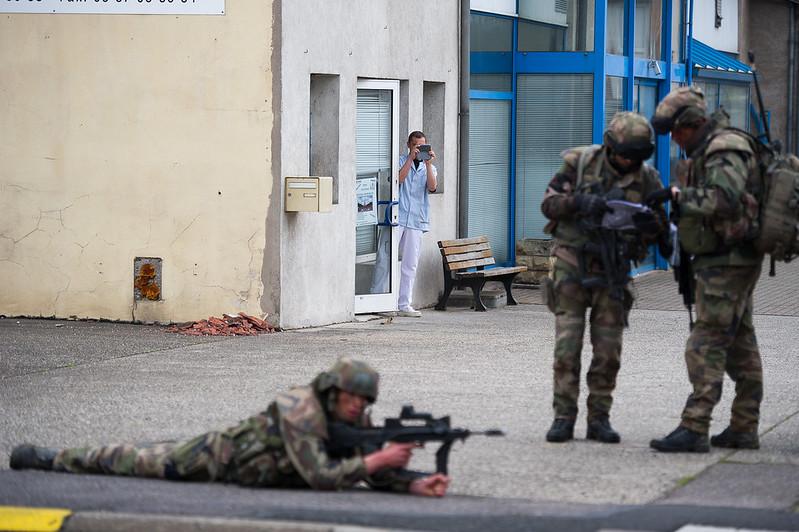Confronting a foreboding future: the French army’s strategic vision
Posted By Ben McLennan on August 14, 2020 @ 13:59

On 6 June 2020, without fanfare, the chief of the French army, General Thierry Burkhard, released his 10-year strategic vision for the Armée de Terre.
The lack of pomp surrounding the launch of Burkhard’s vision, appropriate to France’s Covid-19 situation, doesn’t diminish its significance. The French chief’s approach clearly conveys prescience, purpose, uncomplicated principles and another point of convergence in the growing partnership between the Armée de Terre and the Australian Army.
Before examining the content and characteristics of Burkhard’s plan, it’s worth reviewing its backdrop.
There is broad acknowledgement that the Armée de Terre is undergoing its most consequential change since its 1996 ‘professionalisation’. Triggered in part by the strategic shock of France’s 2015 terrorist attacks, this transformation encompasses force structure and design, force generation, funded modernisation and human resources.
At the same time, the Australian and French armies are pursuing an enhanced bilateral partnership founded on shared missions, agreements, objectives, philosophies, values, programs, opportunities, challenges and geography.
Reflecting its substantial territorial holdings in the Indo-Pacific, its perspective of the near region’s potential and its longstanding leadership ambition, France is actively reinforcing its regional presence, posture and pursuit of both common and unilateral objectives. This reinforcement is manifesting in cooperation between the Armée de Terre’s highly capable elements in New Caledonia and the Australian Army’s combat formations and training centres.
Prescience is a key feature of the Burkhard manifesto. Consistent with Australia’s recent defence strategic update [1]and the army chief’s command statement [2], the general paints a bleak picture of the coming decade. He acknowledges mounting pressure on the European project and the international status quo, increasing employment of emerging technologies for coercive and disruptive means, the acceleration of ‘grey zone’ activities, and escalating internal tensions.
In addition, consistent with the French army’s prognosis on future land warfare, Burkhard infers the end of three prevailing premises: Western military superiority, the trend of limited wars, and efficiency as the cornerstone of political–military thinking. In this context, ‘efficiency’ means deploying the best-tailored forces, drawn from compact techno-professional armies, to achieve a disproportionate political, operational and reputational impact—with the bare minimum of boots on the ground.
Finally, Burkhard portends high-intensity, multidomain, state-on-state conflict, testing France’s resilience in a manner unseen since World War II, triggered well within traditional warning times.
In response, he presents the Armée de Terre as central to France’s enduring security, stability and prosperity. Burkhard communicates a resolute purpose for the army. He seeks to strengthen its ability to operate, lead, fight and win—no matter the threat or contingency. His goal is for a reinforced land force whose legions are characterised by superior warfighting mass and technology that can rapidly deploy, readily integrate, adapt and persist across all domains. Remarkably, he identifies the Armée de Terre as a strategic capability in its own right—a deterrent role (and prestige) traditionally reserved for France’s nuclear maritime and air forces.
Burkhard articulates four actionable and uncomplicated principles to strengthen the Armée de Terre’s preparedness. Recognising that the French soldier is at the heart of its capability, the first principle is to optimise the potential and professionalism of the army’s people. Second, the army will master the new capabilities and technologies offered by its unprecedented modernisation, ‘changing the way it operates and fights’. A transformation in the level, frequency and intensity of multidomain warfighting and partnership-oriented training is probably the most avant-garde aspect of Burkhard’s vision. It’s the key he will use to unlock his ambition for a land force characterised by superior mass and technology. The French chief identifies this endeavour as his most important to ensure the army’s future readiness. Finally, he seeks to reduce the Armée de Terre’s ‘bureaucratic tempo’, thereby gaining time and improving internal agility, flexibility and responsiveness.
Supporting Burkhard’s approach is an action plan involving 12 projects. These incorporate human resources, modernisation, innovation, doctrine, training, sustainment, reserve force and process reforms.
It may surprise some that in most aspects, and certainly the ones that matter most, Burkhard’s vision for the Armée de Terre is nearly indistinguishable from his Australian counterpart’s intent statements [3]. There’s also an affinity between the French chief’s prescience, purpose and plan and that conveyed by Australia’s recent defence strategic update and force structure plan [4]—particularly the elements referring to strategic context and land power response. This convergence bodes well for two armies committed to working together in pursuit of compatible interests in Australia’s increasingly contested region and beyond.
Article printed from The Strategist: https://aspistrategist.ru
URL to article: /confronting-a-foreboding-future-the-french-armys-strategic-vision/
URLs in this post:
[1] defence strategic update : https://www.defence.gov.au/StrategicUpdate-2020/docs/2020_Defence_Strategic_Update.pdf
[2] army chief’s command statement: https://www.army.gov.au/our-work/army-motion/command-statement
[3] intent statements: https://www.army.gov.au/our-work/army-motion/armys-contribution-defence-strategy
[4] force structure plan: https://www.defence.gov.au/StrategicUpdate-2020/docs/2020_Force_Structure_Plan.pdf
Click here to print.